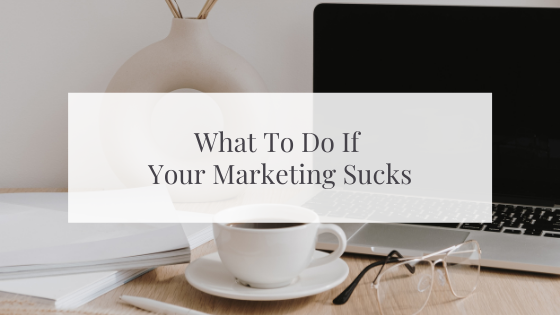If you’ve ever found yourself muttering, “Ugh, my marketing just isn’t working,” you’re not alone. You’ve tried posting consistently, you’ve dabbled in trends, you might even have a whole content calendar built out. And yet? Crickets. Or worse… bad-fit referrals keep rolling in, but your content (or any of your marketing) doesn’t feel like it’s doing anything to attract better-fit clients.
Here’s the good news: Your content probably doesn’t suck. But your strategy, clarity, and connection might be off.
Let’s unpack 3 reasons your content isn’t converting and how to shift your approach to get results that feel aligned.
1. You’re Still Trying to “Reach More People” Instead of the Right Ones
You already know you need an ideal client. But specificity doesn’t stop at understanding demographics. Knowing you’re trying to reach a “female service provider in her 30s” isn’t enough. That information needs to bleed through everything. It should show up in every post you publish, caption you write, and headline you create.
For example, “10 Design Tips For Better Content” is generic AF and honestly? It’s scroll-past-able, but if you’re talking to coaches DIYing their marketing? Trying something more like “5 Canva Hacks To Make Your Coaching Workbook Look Pro” would probably catch their attention mid-scroll.
See the difference? One could apply to anyone. The other is like whispering directly to the coach who’s spending hours fiddling with her PDFs and just wants it to look good.
Your audience isn’t searching for vague value. They’re searching for solutions to their hyper-specific problems. So when your content mirrors their language, tools, and urgency…it resonates and makes them pay attention.
Content Tips To Remember:
- Get clear on exactly who your content is for.
- Use keywords and phrases they’d actually type into Google, YouTube or ChatGPT. Think about the language they’re using in DMs, discovery calls, and search bars (not the jargon you picked up from a copywriting course)
- Write headlines that feel like, “Wait…can she see me??? That’s literally me!”
2. You’re Creating Content Without a Strategic Purpose
If you are not hyper-focused and specifically targeting your ideal customer in everything that you do, your content will never be found by the people who need it most.
Let me say the quiet part louder: not all content should be created equal.
Most content creators are stuck on the hamster wheel of “I should post something”… so they do. But without a clear business objective, your content will always feel like it’s floating with no anchor.
Content that earns its keep by supporting your actual revenue or visibility goals.
Are you trying to: Sell out a service? Book more qualified discovery calls? Grow your list with aligned leads? Great! Now reverse engineer your content to lead there.
Content Tips To Remember:
- Pick 1–2 business priorities per quarter and have all your content and build content pillars that ladder up to those priorities.
- Measure your success by alignment (not just likes)
3. You’re Treating Content Like Confetti Instead of a Flywheel
Most people are stuck in “post once and pray” mode. You post a genius thought, it gets a few saves, and then… poof…you’re on to the next thing. But in reality? Your people need to hear the same core message in 17 different ways before it clicks.
Content clarity = repetition, not reinvention.
Content Tips To Remember:
- Choose 2–4 signature themes that align with your offers and expertise.
- Repurpose your best thinking across formats—carousel, caption, podcast, blog, email.
- Build content systems, not just content pieces.
If one post pops off, don’t clap once and walk away. Turn it into a series. A reel. A story sequence. A newsletter. A blog. Have your content work for you.
If your marketing feels like it’s “not working,” I’d bet good money it’s not about lack of trying and more so about lack of alignment.
Your people need to see you clearly. And that only happens when your content reflects where you actually are, what you’re actually offering, and how you actually help.
